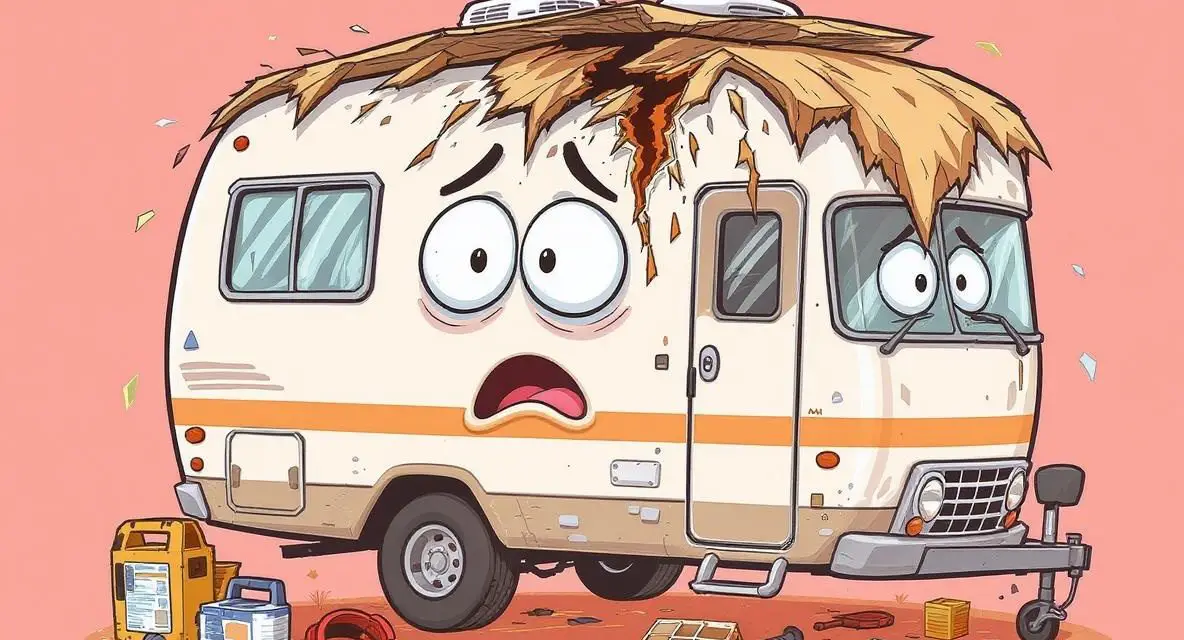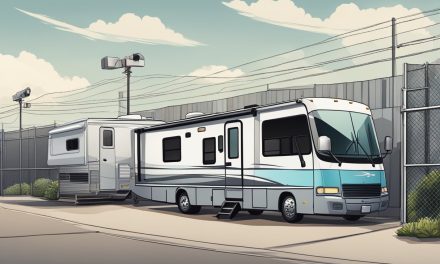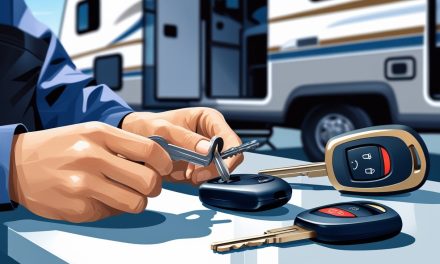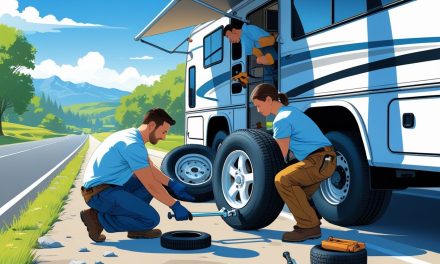Would you like to save this article?
You’ve probably heard the horror stories whispered around RV campgrounds – tales of Winnebago roofs that peel off like sunburned skin and leave owners with repair bills that could buy a decent used car.
But what you’re about to discover will shock you even more than finding a puddle of water on your dining table after a light drizzle. The truth about Winnebago roof failures isn’t just disappointing – it’s downright infuriating when you realize how preventable these problems really are. After watching AZ Expert tear apart yet another failed Winnebago roof in Mesa, Arizona, the pattern becomes crystal clear: these aren’t isolated incidents or bad luck stories.
They’re the inevitable result of what appears to be a design philosophy that prioritizes initial cost savings over long-term durability. Get ready to learn why your beautiful Class A might be ticking time bomb sitting in your driveway.
1. Your Winnebago Roof Has ZERO Structural Support
The Shocking Reality: When you peek inside a Winnebago roof, you’ll discover something that would make any construction worker quit on the spot – there’s absolutely no framing whatsoever. That’s right, your multi-hundred-thousand-dollar home on wheels relies entirely on styrofoam for structural integrity between the ceiling and roof.
According to industry data, traditional stick-built homes use wooden trusses or steel beams spaced every 16-24 inches for roof support. RV manufacturers like Winnebago? They use expanded polystyrene foam and pray it holds up under highway vibrations and weather extremes.
The Professional’s Take: It’s like building a house of cards in a hurricane and expecting it to stay standing. When repair shops have to install temporary support beams just to walk on the roof without causing a cave-in, you know something’s fundamentally wrong with the engineering. The fact that landscape timbers become essential equipment for roof work should tell you everything you need to know about structural integrity.
2. Winnebago’s Screw Game is Weaker Than Gas Station Coffee
The Hardware Horror Show: In the video, the technician pulled out nearly an entire box of broken screws – we’re talking about 85 out of 100 screws that snapped off during removal. These weren’t ancient screws from a 1970s rig; this was a 2007 Itasca Meridian that should have had decades of life left.
The real kicker? Winnebago experimented with Torx T20 screws for about a year before abandoning the idea, suggesting even they knew there were problems. Industry statistics show that proper marine-grade stainless steel screws can last 20-30 years in outdoor applications, but these Winnebago screws were failing after just 7 years.
| Screw Type | Expected Lifespan | Winnebago Reality | Failure Rate |
|---|---|---|---|
| Marine Grade Stainless | 20-30 years | N/A | <5% |
| Standard Galvanized | 10-15 years | N/A | <15% |
| Winnebago T20 Torx | Should be 15+ years | 7 years | 85%+ |
The Brutal Truth: When your RV’s screws have a higher failure rate than a freshman’s first attempt at calculus, you’re essentially driving around in a vehicle held together by hope and duct tape. The fact that repair shops now budget for complete screw replacement as standard procedure should make every Winnebago owner nervous.
3. Delamination Happens Faster Than You Think
The Sneaky Destroyer: Roof delamination doesn’t announce itself with fireworks and fanfare. It starts as tiny bubbles or soft spots that you might dismiss as normal wear. But according to HeyRV, “RV delamination is more common than RV manufacturers would like to admit” and can progress from minor to catastrophic in just one season.
The 2007 Meridian in the video looked decent from a distance, but closer inspection revealed extensive delamination along entire sides of the roof. This pattern is so common that experienced RV technicians can spot potential failures just by looking at the edge seams and feeling for soft spots.
The Reality Check: Thinking your roof is fine because it “looks okay” is like thinking the Titanic was unsinkable because it looked impressive. By the time delamination becomes visible from ground level, you’re already looking at a repair bill that could fund a nice vacation to Europe instead.
4. The Repair Costs Will Make You Question Your Life Choices
The Financial Nightmare: Professional RV roof replacement costs range from a gut-wrenching $175-$325 per linear foot, with most jobs running between $5,000-$15,000 depending on your RV’s size. For a 40-foot Class A, you’re looking at potential costs of $12,000-$15,000 for a complete roof replacement.
Compare this to preventive maintenance: regular roof inspections cost $100-$200, and minor sealant repairs typically run $300-$800. The math is brutally simple – neglecting a $200 inspection can lead to a $12,000 roof replacement.
The Painful Truth: Spending more on roof replacement than most people pay for a brand-new economy car really puts things in perspective. You could buy a reliable used truck for what Winnebago roof replacement costs, and that truck would probably last longer than your RV’s next roof.
5. The “Self-Leveling” Sealant is Actually Self-Sabotaging
The Compatibility Catastrophe: Winnebago uses self-leveling silicone sealant that creates a compatibility nightmare for future repairs. When owners try to patch problem areas with standard RV sealants, the products won’t adhere properly, leading to more leaks and accelerated failure.
The video shows clear evidence of this problem – areas where owners attempted DIY repairs with incompatible sealants, creating weak spots that actually made the delamination worse. This proprietary sealant approach forces owners into expensive professional repairs or complete roof replacement.
The Frustrating Reality: It’s like designing a car that only accepts one specific type of gas that’s only available at three stations in the entire country. Winnebago’s sealant choice seems designed to ensure you can’t perform effective DIY maintenance, forcing you back to authorized repair facilities.
6. Your Warranty Won’t Save You (And Here’s Why)
The Fine Print Fiasco: Most RV warranties specifically exclude water damage and structural issues related to delamination, especially if there’s any evidence of owner maintenance attempts. Since roof problems often don’t surface until years 3-7 of ownership, you’re typically well past the structural warranty period.
Insurance companies also frequently deny claims for gradual damage like delamination, classifying it as maintenance issues rather than sudden catastrophic failure. This leaves owners completely exposed to the full repair costs.
The Harsh Truth: Expecting your warranty to cover roof delamination is like expecting your health insurance to pay for cosmetic surgery – technically possible but practically unlikely. The fine print is written by lawyers whose job is to find reasons not to pay, not to make your life easier.
7. The “Fix” Creates New Problems
The Endless Cycle: Even after spending thousands on professional roof replacement, you’re not guaranteed a permanent solution. The fundamental design flaws – inadequate structural support, questionable material choices, and incompatible sealant systems – remain unchanged in most repairs.
Many repair shops, like Cassone’s RV featured in the video, have developed their own improved methods using better materials and additional support structures. However, these modifications often void remaining warranties and can create compatibility issues with standard RV parts.
The Sobering Reality: Getting your Winnebago roof “fixed” is like putting a Band-Aid on a broken leg – it might look better temporarily, but the underlying problems are still there, waiting to resurface when you least expect (or can afford) it.
SOURCES
- AZ Expert YouTube Channel – Winnebago Roofs: Failure By Design
- RV Life – RV Delamination Guide
- HeyRV – RV Delamination: What It Is & How to Fix It
- RV By Life – RV Roof Replacement Cost & Maintenance
- iRV2 Forums – AZ Experts Slams Winnebago Roof Discussion
- Cassone’s RV – Mesa, Arizona





